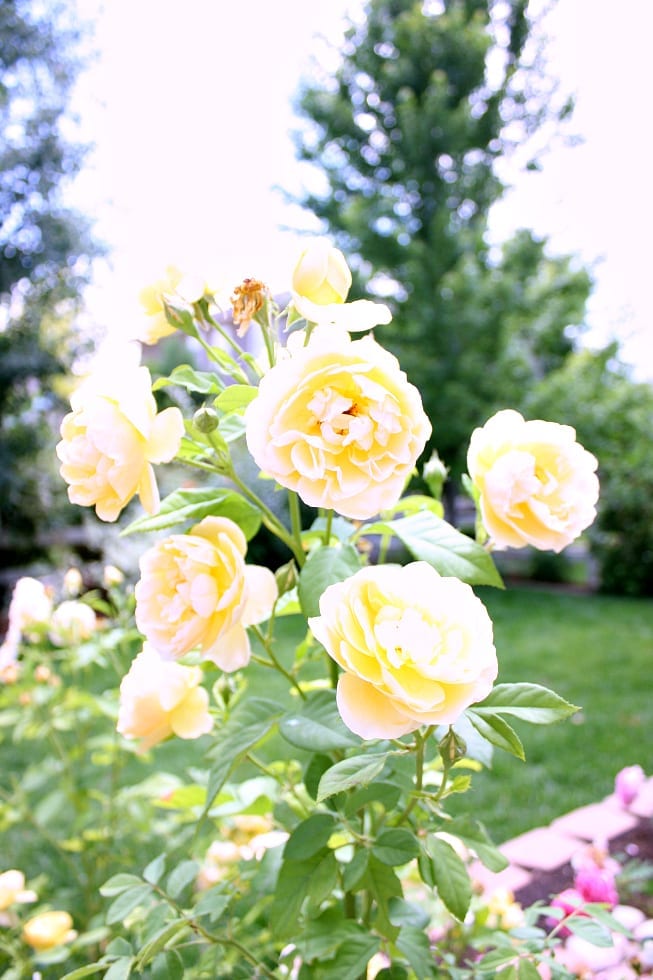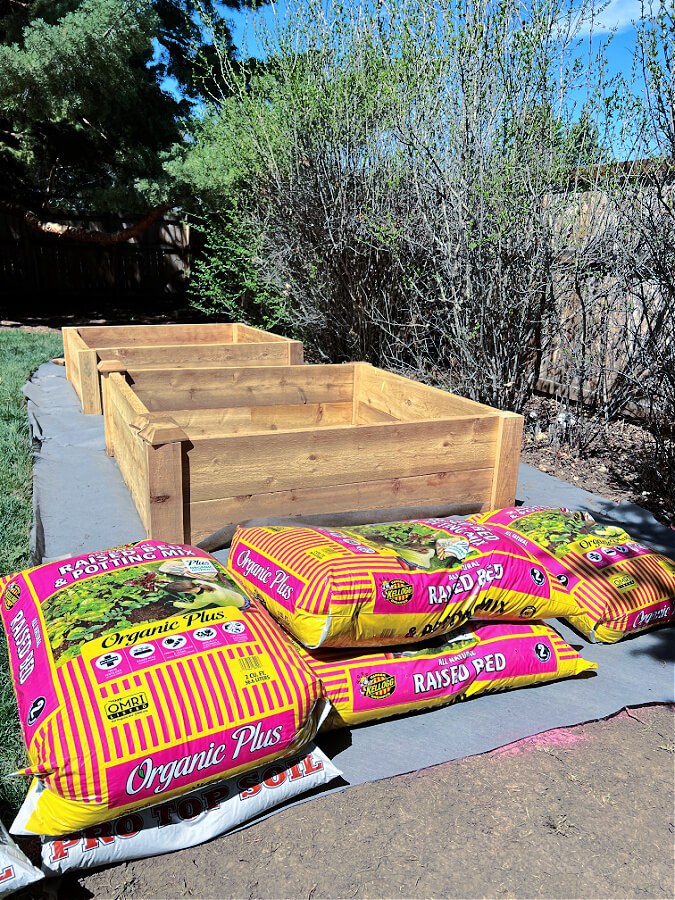The Lazy Girl’s Guide to Planting Colorful Cosmos from Seed
I love beautiful gardens but don’t always have the time or energy for high-maintenance plants. That’s why I’m excited to share how effortless it is to grow vibrant cosmos flowers from seed. With just a bit of prep, you can enjoy a stunning garden without the hard work.

*As an Amazon Associate, I earn from qualifying purchases. This post contains other affiliate links too for your convenience. Click here to read my full disclosure policy.
Cosmos flowers are perfect for low-effort gardening. I clearly remember my mom growing comos when I was growing up and I loved how whimsical they looked. At one point they took over our back fence arear without any effort from my mom. That was when I knew they fit in the Lazy Garden Girl club!
They’re annuals that bloom from summer to fall, growing effortlessly from seeds. They even thrive in poor soil, making them ideal for busy gardeners. Plus, they attract birds, bees, and butterflies, creating a lively garden.
Disclaimer
Just to be clear, I am by no means a flower expert. I just love getting my hands dirty and sharing what works for me in hopes that it will work for you, too. I encourage you to do zinnia research like I did (mainly on Google and Pinterest) to see how they will best work for you and your garden zone. We live in northern Colorado, which is zone 5b, but these tips are very general and will work for all zones.
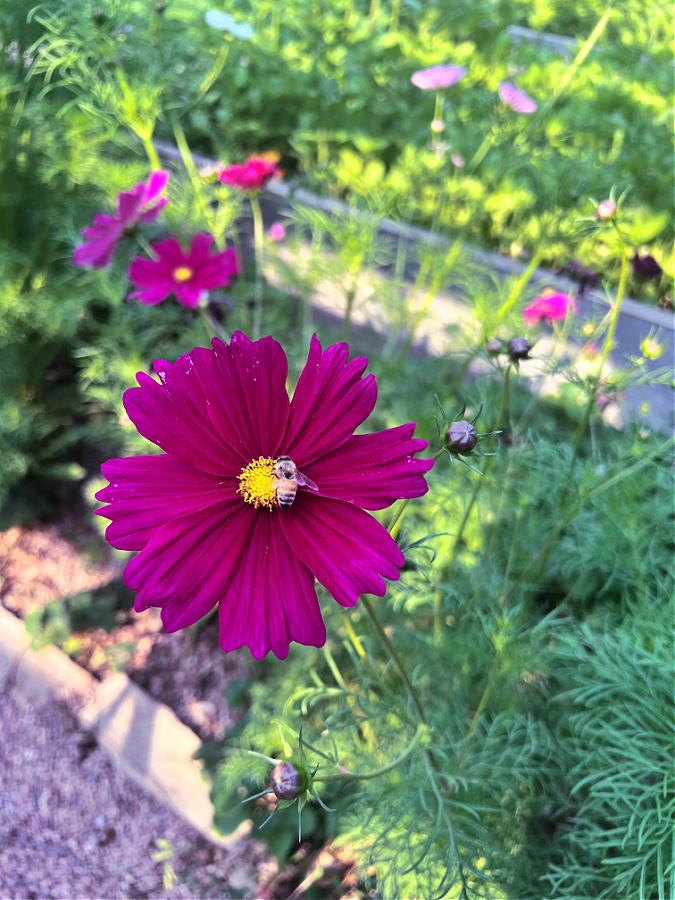
What are Cosmos?
Cosmos are annual flowers that are native to Mexico. They belong to the Asteraceae family and are closely related to daisies and sunflowers. Cosmos are known for their delicate, daisy-like flowers that come in shades of pink, white, red, and orange. They bloom from midsummer to fall and can grow up to 4 feet tall.
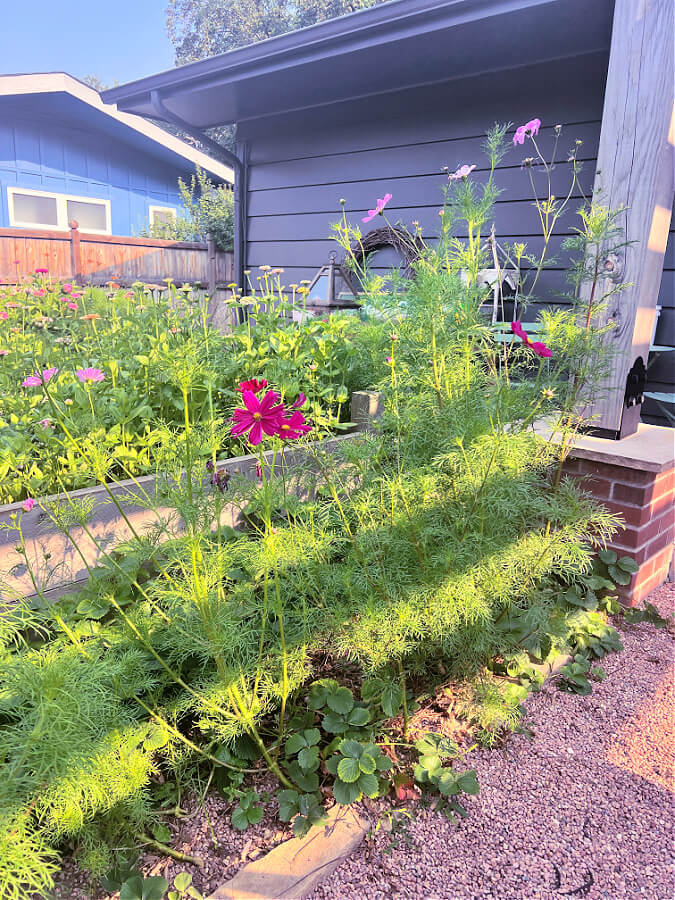
Why Plant Cosmos?
There are many reasons to plant cosmos in your garden. They are low maintenance and easy to grow, making them perfect for beginner gardeners. They attract bees, butterflies, and other pollinators to your garden, which helps to improve the health of your plants. Cosmos also make great cut flowers, so you can bring a little bit of your garden inside.
Are Cosmos Really That Easy to Grow?
Absolutely! Cosmos are one of the easiest flowers to grow from seed, making them a perfect choice for beginners. Here’s why:
- Quick germination: Cosmos seeds sprout in 7-21 days.
- Low maintenance: Once established, they need little care.
- Long blooming: Cosmos flowers bloom from midsummer to frost.
- Attract pollinators: Bees and butterflies love them, supporting local ecosystems.
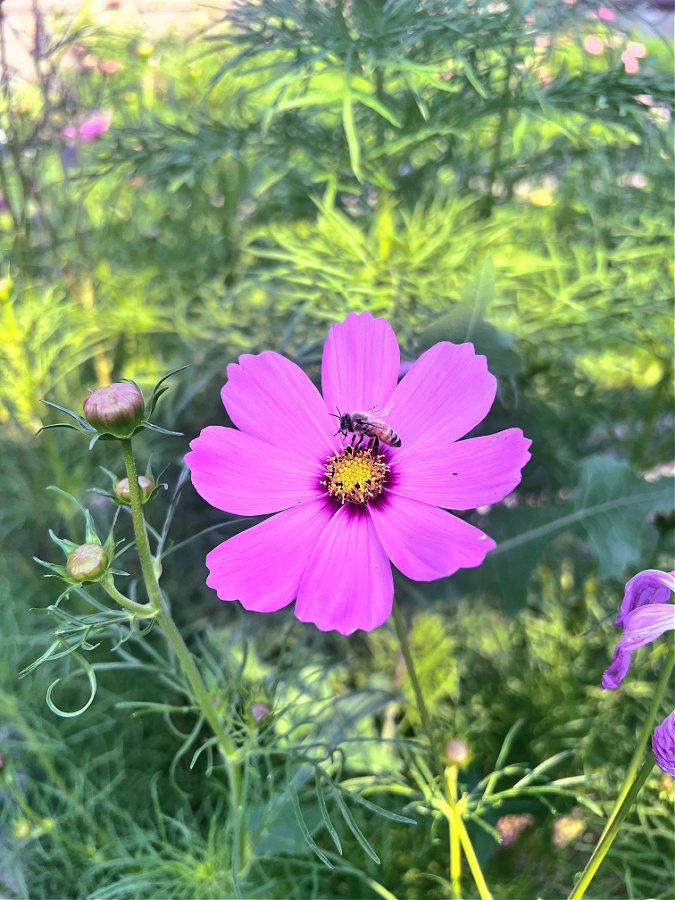
The Lazy Girl’s Guide to Planting Colorful Cosmos from Seed
In this guide, I’ll share my tips for planting cosmos from seed. Whether you’re an experienced gardener or a beginner, you can easily grow beautiful cosmos flowers in your own garden. These ones are almost as fun as zinnias!
How Do You Start Cosmo Seeds Outdoors?
Starting cosmos seeds outdoors is a simple and delightful gardening project, making colorful blooms all summer. Here’s a simplified guide:
- Choose a Sunny Spot: Pick a place with at least 6 hours of sunlight daily.
- Prep the Soil: Cosmos aren’t picky, but they prefer well-draining soil. Add compost or sand if your soil is heavy.
- Plant the Seeds: Scatter them lightly on the soil. There is no need to bury them deep and sometimes I sprinkle a little dirt on top but not much. Late spring, after the last frost, is a good time.
- Water Carefully: Water gently to avoid washing away seeds. Keep the soil moist but not soaked until they sprout.
- Give Space: When seedlings reach a few inches, thin them out, leaving about 12 inches between plants. They fill in quickly so this is a helpful step!
- Enjoy the Blooms: In about 3 months, the cosmos will start blooming and continue until the first frost. Remove dead blooms to encourage more flowers.
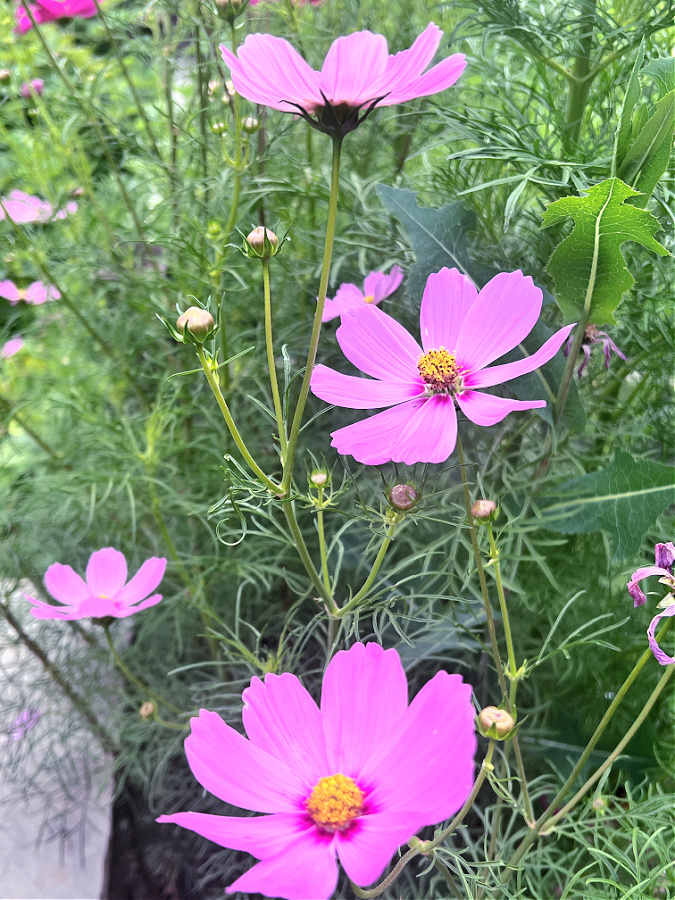
Where Should I Buy Cosmo Seeds?
When you want to get cosmo seeds, you’ve got a few choices. Here are some good places to find them:
- Local Garden Centers and Nurseries: Your nearby garden shops are a great option. They usually have a variety of seeds and can suggest which ones will grow best where you live. You might even find seeds tailored to your local climate and soil.
- Online Stores: You can also shop online. Big websites like Amazon and smaller specialty seed stores offer Cosmo seeds. Just be sure to read reviews and check if the seller is reliable. I tried several from Botanical Interests and these and loved them.
- Seed Swaps: If you’re on a budget or want to try different cosmo varieties, consider joining a seed swap. These events let gardeners trade seeds, often for free or cheap. Find exchanges near you in local gardening groups or online gardening forums.
- Harvest Your Own: Saving Cosmos seeds isn’t too hard. Once your blooms are looking wilted on the stem, cut below the flower head. Then dry the head in a cool place for a few weeks making sure there is no moisture. Then pull apart and look for tiny slender sword like seeds. save these in a jar and that’s it!
No matter where you get your cosmo seeds, make sure to read the seed package carefully and follow the instructions for planting and looking after your plants. With some care, you can have a lovely garden full of these beautiful flowers.
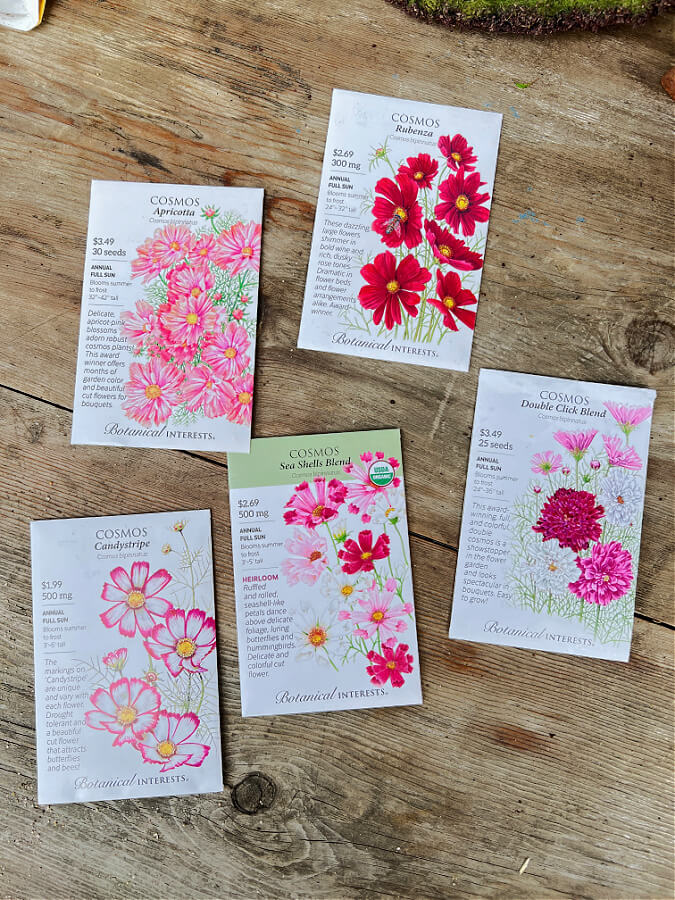
Should I Soak Cosmo Seeds Before Planting?
I’m all about finding the easiest way to do things, especially when it comes to gardening. So, when it comes to planting cosmos seeds, I often wonder if soaking them before planting is worth the effort or just an extra step.
After some research and testing, I’ve learned that soaking cosmos seeds before planting isn’t necessary, but it can speed up the germination process.
When you soak cosmos seeds, you’re basically giving them a head start by softening their tough outer shell. This helps the seeds absorb water and nutrients more easily, leading to quicker sprouting.
But if you’re short on time or just feeling a bit lazy, you can totally skip this step and still get good results. Just remember to plant your seeds in soil that drains well and keep that soil nice and moist until your seeds start to sprout.
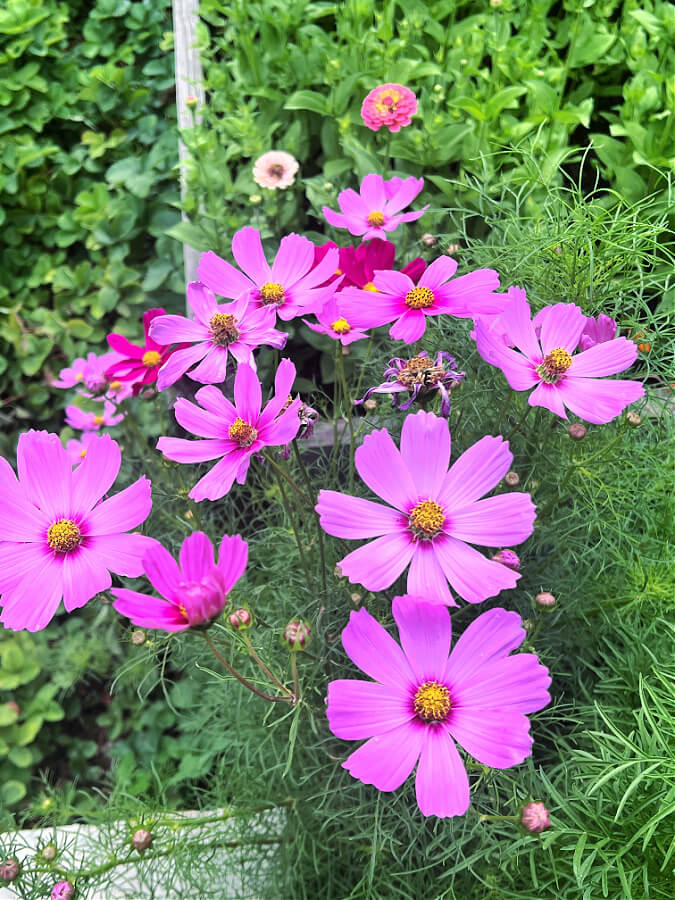
What Zones Do Cosmos Grow In?
Cosmos flowers are pretty flexible and can thrive in different climates. People often plant them as annuals, but they can grow as perennials in warmer climates.
Cosmos plants are hardy in USDA zones 2-11. They like lots of sunlight and soil that drains well.
Here’s a quick summary of their ideal conditions:
- Soil pH-6.0–6.8 (Acidic)
- Bloom Time- Summer through fall
- Flower Color-Various (e.g., golden yellow, white, pink, magenta, orange, yellow, red, chocolate)
- Hardiness Zones- 2–11 (USDA)
If you live in a cooler spot, don’t worry. You can still have cosmos in your garden by planting them as annuals. These flowers are easy to grow from seeds, and you can sow them directly in your garden after the last frost.
How Can I Make Sure My Cosmos Bloom in the Fall?
To make sure my cosmos flowers bloom in the fall without too much work, here are some easy tips:
- Deadheading: This means removing old, faded flowers. It helps the cosmos keep blooming and look neat.
- Watering: Cosmos like soil that drains well but stays moist, not soggy. Water them regularly, especially when it’s dry. But guess what? I barely watered mine and they are great!
- Fertilizing: Cosmos don’t need a lot of food, but a little fertilizer once a month can encourage more blooms. When I remember to fertilize them (ha!) this is my go to fertilizer. I use it on my zinnias too!
- Sunlight: Cosmos love the sun, so plant them where they’ll get at least six hours of direct sunlight daily.
- Timing: Plant cosmos in the spring once the frost danger is gone. This gives them time to grow strong before they start blooming in the fall.
With these easy steps, you can enjoy beautiful cosmos flowers in the fall without too much fuss.
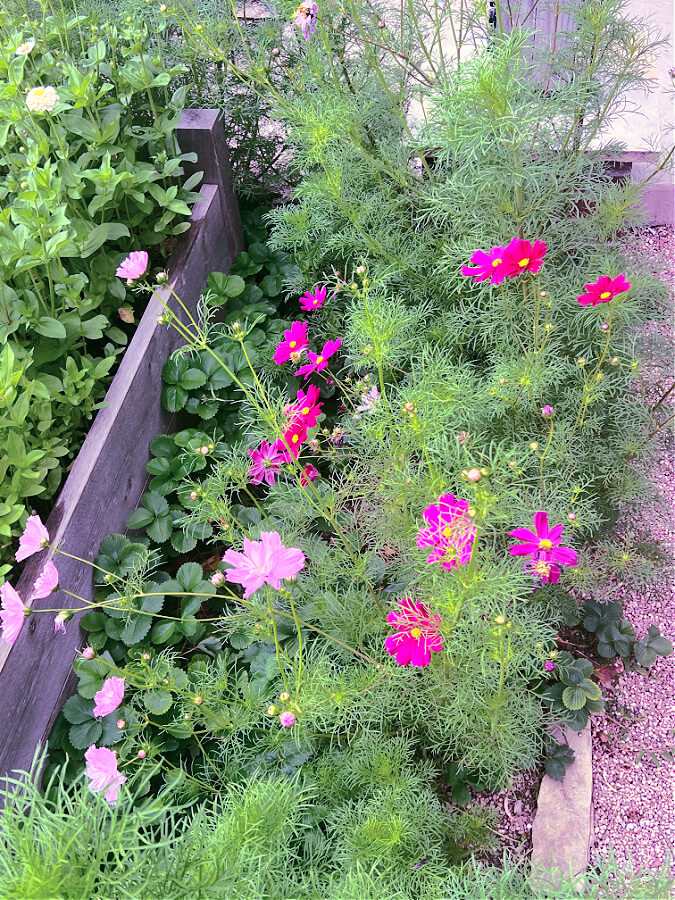
Where Do You Cut Cosmos for Regrowth?
Pruning cosmos may sound tricky, but it’s all about cutting in the right places to help your plant grow better. Here’s a simple guide on where to snip for healthier cosmos:
- Remove dead flowers: To get more blossoms, pinch off old flowers just below the flower head. This tells the plant to make new blooms instead of seeds.
- Pinching: Just like with zinnias, cosmos can be pinched! You do this just above the third set of leaves. This will encourage them to branch out and have more blooms. Obviously this is not necessary and you can just let them do their thing as well! I’ve done both:)
- Trim the stems: To boost your cosmos flower yield, trim them as the blooms start opening with sharp scissors at a leaf node. This encourages branching, resulting in more flowering stems and abundant cosmos blooms.
- Take out dead or sickly stems: If any stems look dead or damaged, get rid of them ASAP. Cut back to healthy tissue above a leaf spot to prevent any illness from spreading.
- Thin crowded areas: If your cosmos are crowded, trim some stems at the base. This opens things up so more air and light can reach the remaining stems, making them healthier.
And always use clean, sharp pruning shears. Disinfect them between cuts to keep your cosmos in good shape.
How Tall Do Cosmos Get?
Cosmos are well-known for their slender stems and airy leaves, making them a lovely choice for gardens. Their height varies based on the type and growing conditions. Here’s a simple guide to their heights:
- Most Cosmos typically range from one to six inches in height. But they can also get huge and take over as well! So read the height on your seed packets and choose wisely.
- Factors like sunlight, soil quality, and watering can influence their final size.
- Shorter Cosmos types work well in pots, while taller ones may need support to stay upright.
Here are some popular Cosmos varieties and their usual heights:
Variety/Height Range
- Sonata / 20-24″
- Sensation/ 48-72″
- Double Click/ 36-48″
- Cupcakes/ 36-48″
- Bright Lights/ 36-48″
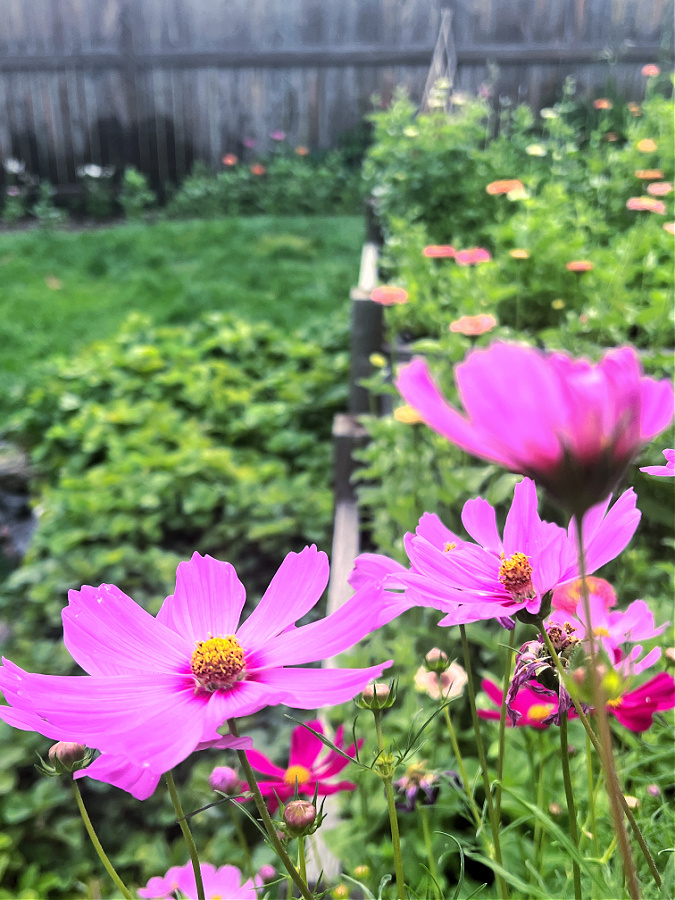
Do Cosmos Self Seed?
YES they do! Cosmos can self-sow, but the seeds from this late-season germination often result in short-lived plants. Occasionally, you might find seeds that stayed in the ground through the winter and sprout the following year, but these are unlikely to be exactly like the parent plant.
After planting my raised bed full of cosmos, then deciding I wasn’t a fan of them in the raised bed, I didn’t plan to plant them again. But guess what? They re-seeded themselves all around my raised beds and I let them go wild! I am loving them. Below isa picture of the ones that self seeded!
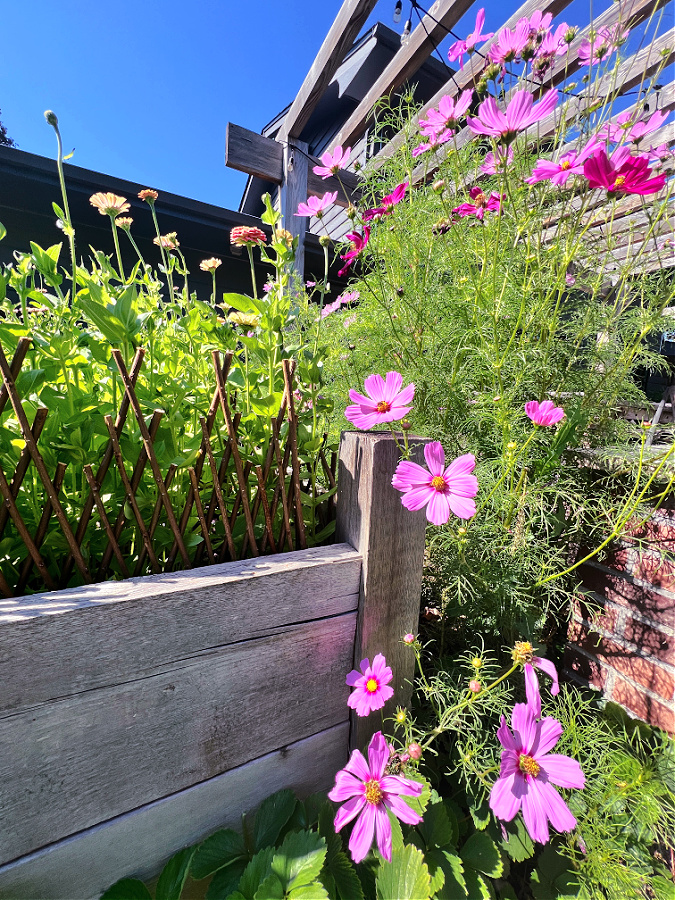
Can You Grow Cosmos in Pots?
Being a gardening enthusiast who appreciates ease, I’ve discovered that growing cosmos in pots is a fantastic solution. It’s simple and lets me enjoy these lovely flowers without the hassle of planting them in the ground.
Cosmos are a great fit for container gardening, and they thrive in pots. This method allows you to bring color to your balcony, patio, or any small area you have available. Here are some pointers for successfully growing cosmos in pots:
- Container Size: Select a container with a minimum depth of 12 inches and a broad base to prevent tipping, especially when dealing with taller cosmos varieties. Also, make sure that it is a self-draining container.
- Soil: Cosmos prefer well-draining soil that’s enriched with organic matter. Use a high-quality potting mix designed for container gardening. Mixing in compost or other organics can enhance the soil.
- Watering: Cosmos require regular watering, especially in hot, dry conditions. However, avoid overwatering, as it can harm the plants. Check the soil moisture by inserting your finger into it. If it’s dry, it’s time to water it.
- Fertilizing: While cosmos don’t need heavy feeding, they benefit from occasional fertilization.
FAQ About Growing Cosmos from Seed
1. Can cosmos flowers be grown in containers?
- Yes, cosmos can be grown in containers. Choose a large pot with good drainage and use a light, well-draining potting mix. Ensure they get plenty of sunlight.
2. Are cosmos flowers perennials or annuals?
- Cosmos are typically grown as annuals, but in some warmer climates, they can self-seed and return the next year.
3. How tall do cosmos plants grow?
- Depending on the variety, cosmos plants can grow anywhere from 1 to 6 feet tall. Some dwarf varieties are suitable for small gardens or containers.
4. What pests and diseases affect cosmos flowers?
- Cosmos are relatively pest-free but can occasionally be affected by aphids, spider mites, or powdery mildew. Regular inspection and appropriate treatments can help manage these issues.
5. How do you deadhead cosmos flowers?
- To deadhead cosmos, simply snip off the spent blooms just above the nearest set of leaves or buds. This encourages the plant to produce more flowers.
6. Can cosmos be grown from cuttings?
- While cosmos are typically grown from seeds, they can also be propagated from cuttings. Take a cutting from a healthy plant, remove the lower leaves, and place it in water or moist soil until it roots.
7. Do cosmos flowers attract pollinators?
- Yes, cosmos are excellent at attracting pollinators like bees, butterflies, and hummingbirds, making them a great addition to any garden.
8. How long do cosmos seeds take to germinate?
- Cosmos seeds usually take about 7 to 10 days to germinate, depending on the soil temperature and conditions.
9. Do you need to pinch cosmos and how?
- Yes, pinching cosmos can help encourage bushier growth and more blooms. To pinch cosmos, wait until the plants are about 12-18 inches tall. Using your fingers or pruning shears, pinch off the top few inches of the plant, just above a set of leaves. This will encourage the plant to branch out and produce more flowers.
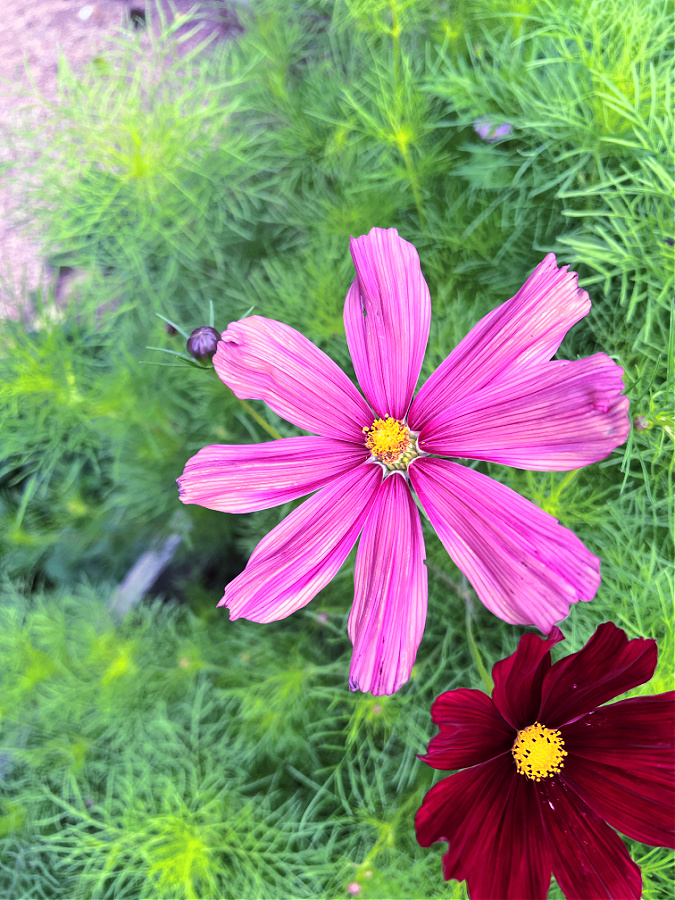
The Lazy Girl’s Guide to Planting Colorful Cosmos from Seed
So are you adding these beauties to your list?
Growing cosmos from seeds is a simple and enjoyable way to bring vibrant colors to your garden. You can effortlessly create a stunning display of daisy-like flowers that will attract bees, butterflies, and other pollinators. Here’s a simple checklist to get you started:
Choose the Right Spot: Pick a sunny area in your garden with well-draining soil.
Sow Seeds: Plant the seeds directly in the soil, or scatter them after the last frost, or start them indoors 4-5 weeks before the last frost.
Proper Watering: Keep the soil consistently moist, but avoid overwatering, as they dislike waterlogged conditions.
Encourage Fuller Growth: When your cosmos seedling has grown its first 2-3 sets of true leaves, gently remove the tip at the very top to encourage full growth.
Deadhead Spent Blooms: Extend the flowering season by removing dead blooms.
Seed Harvest: In the fall, gather seeds and store them in a cool, dry place for future planting.
Cosmos plants are perfect for lazy gardeners because they require minimal attention and deliver colorful blooms throughout the season. So, don’t hesitate—sprinkle some cosmos seeds in your garden and relish their beauty!

I’d love to have you hang out with me some more! Feel free to follow along with me on any of the platforms linked below.
LTK | Facebook | Instagram | Pinterest | Amazon
xoxo,
Kelly
Did you like this post? PIN it for later!




